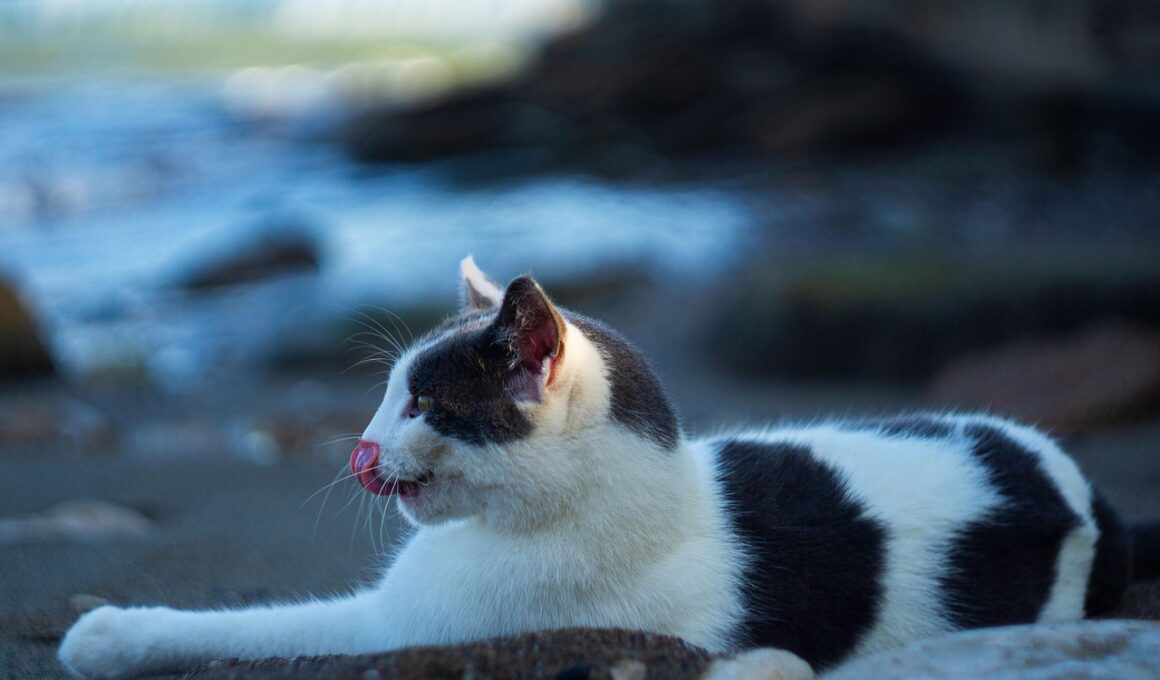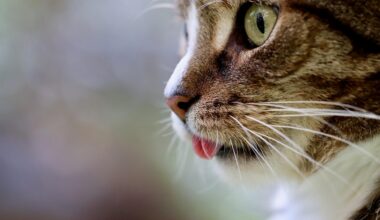Understanding the Pathophysiology of Congestive Heart Failure in Cats
Feline congestive heart failure (CHF) is a significant and common condition in domestic cats, often resulting from various underlying issues. The most frequently identified causes of CHF in cats include cardiomyopathy, mitral valve disease, and hypertension. Understanding the pathophysiology of CHF in cats requires a grasp of how cardiac function is compromised. The heart’s ability to pump effectively diminishes, leading to fluid accumulation in tissues. Affected cats often present with clinical signs such as coughing, labored breathing, and lethargy. In some cases, edema may develop, notably in the abdomen and lungs. Diagnosing CHF typically involves thorough veterinary examinations, including blood tests, X-rays, and echocardiography. Early detection is crucial for implementing timely treatment measures. Furthermore, CHF can progress quickly and may prove fatal if not appropriately managed. Owners must monitor their feline companions closely for any abnormalities in behavior or health. If any signs of distress appear, immediate veterinary attention is essential to minimize health risks associated with this life-threatening condition. Understanding these dynamics can help cat owners take proactive steps in managing their pets’ health.
Pathophysiological Changes in Congestive Heart Failure
In CHF, the heart undergoes several pathophysiological changes which ultimately compromise its function. The initial insult often leads to a compensatory response where the heart tries to maintain adequate circulation. This response may include hypertrophy, in which heart muscles thicken to enhance cardiac output. However, as the disease progresses, these compensatory mechanisms may cause more harm than good. Increased pressure in the heart can lead to fluid leakage into surrounding tissues, most notably pulmonary edema, which causes respiratory distress in cats. Additionally, the kidneys may respond to low effective circulating blood volume by retaining sodium and water, further compounding fluid retention. As CHF continues, neurohormonal activation occurs, particularly involving the renin-angiotensin-aldosterone system (RAAS). Increased levels of certain hormones can lead to vasoconstriction, worsening the heart’s workload. Clinicians often witness varied symptoms in affected cats, including sudden onset of coughing, difficulty breathing, and even fainting. Understanding these complex pathophysiological changes can provide critical insight into how to treat and manage CHF effectively, encouraging better outcomes and enhancing quality of life for felines diagnosed with this condition.
The diagnosis of congestive heart failure in cats is multifaceted and necessitates a comprehensive approach. Initially, a veterinarian will conduct a thorough physical examination, paying close attention to heart rate, rhythm, and breath sounds. History taking is critical; any past events, including known heart diseases or significant changes in the cat’s lifestyle, should be documented. Special diagnostic tools like radiographs (X-rays) are invaluable in visualizing the heart and lung fields. Abnormalities, such as fluid buildup in the chest cavity, can indicate CHF. Additionally, echocardiography provides advanced imaging to assess cardiac function and the structure of the heart chambers and valves. Furthermore, electrocardiograms (ECGs) are implemented to evaluate the electrical activity of the heart, detecting arrhythmias or other conduction abnormalities. Blood tests, including cardiac biomarkers like NT-proBNP, enhance diagnostic accuracy. Integrating these methods yields a comprehensive understanding of the cat’s condition, which allows for tailored and effective treatment options. Accurate diagnosis is vital for the early intervention necessary to improve prognosis and quality of life in cats suffering from congestive heart failure, making owner vigilance indispensable.
Common Clinical Signs of CHF in Cats
Identifying common clinical signs of congestive heart failure in cats is vital for prompt diagnosis and treatment. Cats may exhibit a range of troubling symptoms, often leading to increased levels of distress for pet owners. Common signs include coughing, especially following exertion; this is particularly notable in felines that had not previously shown such behavior. Additionally, labored or rapid breathing, known as tachypnea, may become evident, often accompanied by open-mouth breathing or wheezing. Cats with CHF may also demonstrate lethargy, showing reduced interest in activity or play, which is concerning to owners. Furthermore, a decrease in appetite is typical, leading to weight loss over time. Edema may occur, often seen as swelling in the abdomen or legs, pointing towards fluid retention issues. Behavioral changes such as hiding or weakness can indicate advanced stages of the condition. Being species-specific, these symptoms require diligent observation by cat owners for timely veterinary consultations. Early recognition of these clinical signs can significantly increase the chances of successful management and treatment of feline congestive heart failure, enhancing the overall health and well-being of affected cats.
The treatment of congestive heart failure in cats generally focuses on alleviating clinical signs and improving the quality of life for the feline patient. Veterinary practitioners typically initiate therapy with diuretics to help reduce fluid accumulation within the lungs and body. Commonly prescribed diuretics include furosemide, which aids in promoting urine production, thus facilitating the elimination of excess fluid. Beyond diuretics, additional medications, such as angiotensin-converting enzyme (ACE) inhibitors like enalapril, help to lower blood pressure and improve cardiac output. Other medications, including pimobendan, can enhance the heart’s contractility and vasodilatory effects. Dietary management often accompanies pharmacological interventions, concentrating on low-sodium diets to minimize fluid retention. Regular follow-up visits to the veterinarian are crucial for monitoring the cat’s response to treatment and making any necessary adjustments. Owners should maintain excellent communication with their veterinarian about observed changes in the cat’s condition. Furthermore, palliative care may enhance comfort during advanced disease stages. A comprehensive treatment strategy enables better management of feline CHF while ensuring that affected cats can lead comfortable and enriched lives under owners’ care.
Prognosis and Living with CHF
The prognosis for cats diagnosed with congestive heart failure varies widely, influenced by several factors including the underlying cause, age, and overall health. For instance, cats with hypertrophic cardiomyopathy may experience a different trajectory compared to those with valvular heart disease. Managing CHF in felines requires a delicate balance of medical intervention and lifestyle adaptations. Regular veterinary check-ups are essential to monitor the cat’s heart condition and modify treatment as necessary. Owners can play a crucial role in ensuring their cat adheres to prescribed medications and maintains a suitable diet. It’s also vital to manage stress and provide a supportive environment catering to the cat’s comfort. A quiet, safe space can help minimize anxiety and promote overall well-being. Owners are encouraged to familiarize themselves with potential signs of CHF exacerbation, ensuring they remain vigilant for any sudden changes in activity levels or behavior. While a diagnosis of CHF may seem daunting, many cats can live relatively stable and enjoyable lives with proper management and care. Understanding the condition empowers pet owners to enhance their cat’s quality of life through attentive care.
In conclusion, understanding the pathophysiology of congestive heart failure in cats plays a vital role in promoting timely diagnosis and effective management. With various underlying causes, it is essential for cat owners to remain aware of clinical signs indicative of this serious condition. Through thoughtful vigilance and regular veterinary care, potential advancements in treatment allow many cats to receive life-enhancing therapies, leading to better outcomes. The complex interplay of heart function, compensatory mechanisms, and the body’s responses necessitates a nuanced understanding of the disease. With advancements in medical treatment, early detection has become increasingly vital in managing feline CHF. Cat owners must embrace their roles as advocates for their pets’ health, seeking veterinary guidance whenever symptoms emerge. Ongoing education about veterinary practices and emerging therapies can further prepare cat owners to handle their felines’ health needs. Overall, although a diagnosis of CHF presents significant challenges, it is manageable with appropriate strategies and collaborative care from both owners and veterinary professionals. Embracing this understanding allows for a proactive approach that ensures affected felines maintain enriched and fulfilling lives despite their diagnosis.


